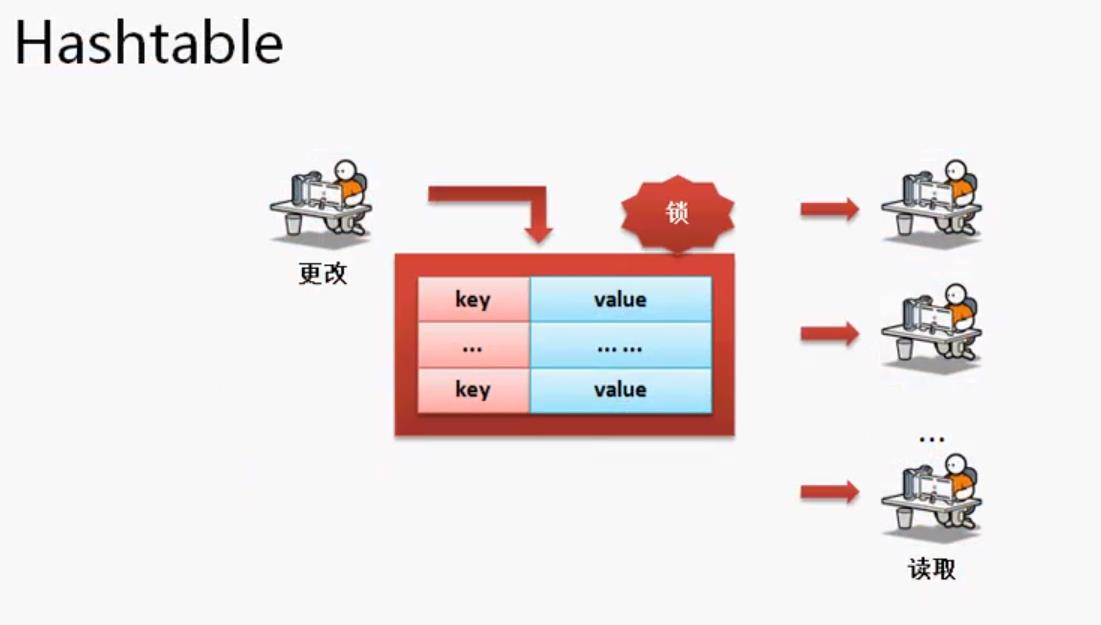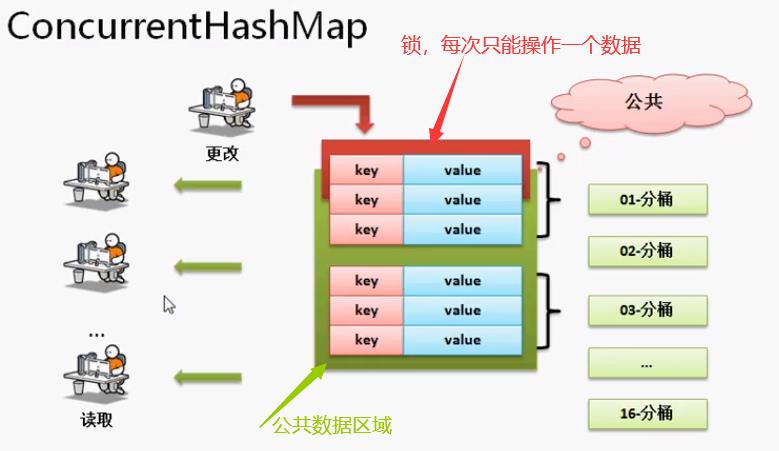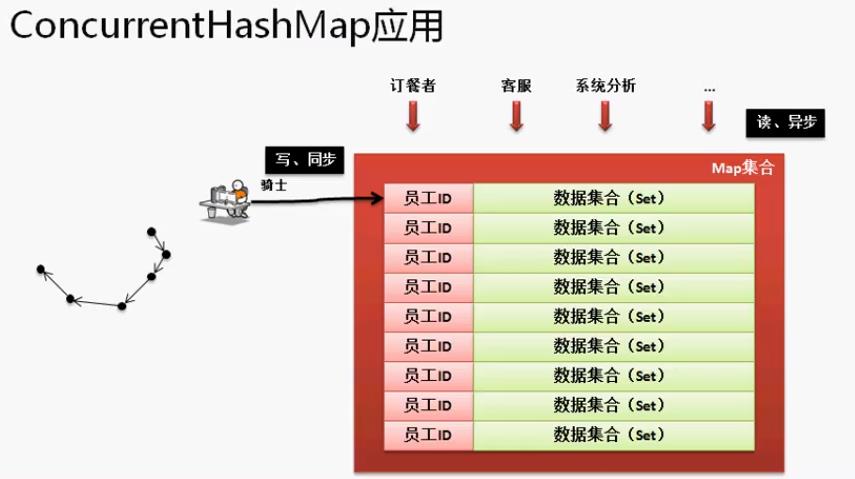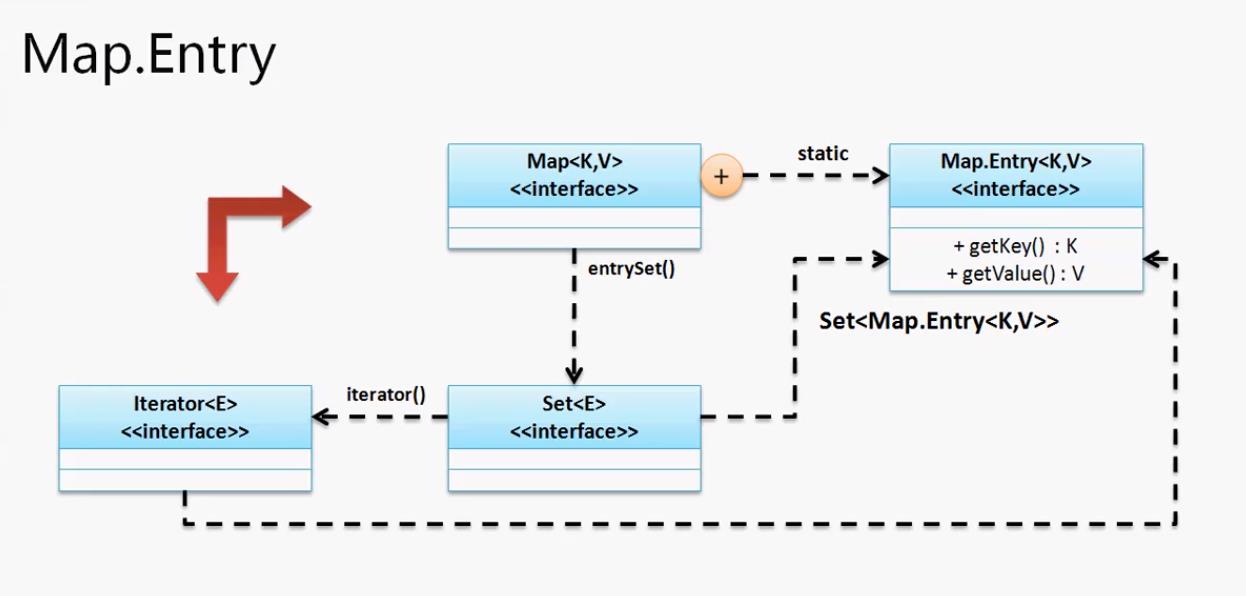# Day18-Java基础
Posted zsr6135
tags:
篇首语:本文由小常识网(cha138.com)小编为大家整理,主要介绍了# Day18-Java基础相关的知识,希望对你有一定的参考价值。
Day18-Java
文章目录
1、Map集合
偶对象指的是一对对象,即:两个对象同时保存,这两个对象是按照了“key=value”的形式进行定义的,即:可以通过key找到对应的value数据,就好像电话本一样,例如,电话本之中保存了如下的信息:
Key =张三,value=123456;
Key=李四,value=234567;
现在如果要想找到张三的电话,那么肯定根据张三的key,取得对应的value,而如果现在要想找到王五的电话,由于没有王五这个key,所以返回的结果就是null。
Map就是实现这样一种操作的数据结构,这个接口之中的定义的主要操作方法如下。
| 方法名称 | 类型 | 描述 |
|---|---|---|
| public V put(K key, V value) | 普通 | 向集合之中保存数据 |
| public V get(Object key) | 普通 | 通过指定的key取得对应value |
| Public Set keyset() | 普通 | 将Map中的所有key以Set集合的方式返回 |
| Public Set<Map,Entry<K,V>>entrySet() | 普通 | 将Map集合变为Set集合 |
在Map接口之中有两个常用的子类:HashMap,Hashtable。
1.1 子类:HashMap
HashMap是Map接口之中使用最多的一个子类
public class HashMap<K,V>
extends AbstractMap<K,V>
implements Map<K,V>, Cloneable, Serializable
HashMap演示Map接口中各个主要方法的作用
验证Map
package com.day18.demo;
import java.util.HashMap;
import java.util.Iterator;
import java.util.Map;
import java.util.Set;
public class HashMapDemo {
public static void main(String[] args) {
Map<Integer,String> map = new HashMap<>();
map.put(1, "Hello,world!!");
map.put(2, "zsr");
map.put(3, ".com");
Set<Integer> keyset = map.keySet();//取得所有的key信息
Iterator<Integer> iterator = keyset.iterator();
while(iterator.hasNext()){
Integer key = iterator.next();
System.out.println(key + "=" + map.get(key));
}
}
}
面试题:解释HashMap的原理
在数据量小的时候HashMap是按照链表的模式存储的。当数据量变大之后,为了进行快速的查找,将这个链表变为一个红黑树(均衡二叉树),用hash码作为数据定位,来进行保存的。
所有的方法都是异步的,属于线程不安全操作。
1.2 子类:Hashtable
jdk1.0提供三大主要类:Vector、Enumeration、Hashtable。
Hashtable是最早实现这种二元偶对象数据结构,由于后期的设计也让其与Vector一样多实现了MMap接口。
package com.day18.demo;
import java.util.HashMap;
import java.util.Hashtable;
import java.util.Iterator;
import java.util.Map;
import java.util.Set;
public class HashtableDemo {
public static void main(String[] args) {
Map<Integer,String> map = new Hashtable<>();
map.put(1, "Hello,world!!");
map.put(2, "zsr");
map.put(3, ".com");
map.put(null, null);
System.out.println(map);
}
}
Exception in thread "main" java.lang.NullPointerException
at java.util.Hashtable.put(Hashtable.java:460)
at com.day18.demo.HashtableDemo.main(HashtableDemo.java:15)
以上Hashtable无法传入空值并对其进行输出。而HashMap可以
package com.day18.demo;
import java.util.HashMap;
import java.util.Hashtable;
import java.util.Iterator;
import java.util.Map;
import java.util.Set;
public class HashtableDemo {
public static void main(String[] args) {
Map<Integer,String> map = new HashMap<>();
map.put(1, "Hello,world!!");
map.put(2, "zsr");
map.put(3, ".com");
map.put(null, null);
System.out.println(map);
}
}
{null=null, 1=Hello,world!!, 2=zsr, 3=.com}
| 区别 | HashMap | Hashtable |
|---|---|---|
| 时间 | JDK1.2 | JDK1.0 |
| 性能 | 采用异步处理方式,性能高 | 采用同步处理方式性能相对较低 |
| 安全性 | 线程安全 | 线程不安全 |
| 设置null | 允许key、value设置为null | 不允许key、value设置为null,否则出现异常 |

1.3 ConcurrentHashMap子类
ConcurrentHashMap 的特点 = Hashtable的线程安全性 + HashMap的高性能,在使用ConcurrentHashMap处理的时候既可以保证多个线程更新数据的同步,又可以保证很高效的查询速度。
public class ConcurrentHashMap<K,V>
extends AbstractMap<K,V>
implements ConcurrentMap<K,V>, Serializable
如果说现在采用一定的算法,将保存的大量数据平均分在不同的桶(数据区域),这样在进行数据查找的时候就可以避免这种全部的数据扫描。
数据分桶
package com.day18.demo;
import java.util.Random;
public class ConcurrentHashMapDemo {
public static void main(String[] args) {
for(int i = 0; i <10 ; i++){
new Thread(()->{
Random random = new Random();
int temp = random.nextInt(9999);
int result = temp % 3;
switch(result){
case 0:
System.out.println("第0桶" + temp);
break;
case 1:
System.out.println("第1桶" + temp);
break;
case 2:
System.out.println("第2桶" + temp);
break;
}
}).start();
}
}
}
采用分桶之后每一个数据必须有一个明确的分桶标记,很明显使用hashCode()。




1.4 Map使用Iterator输出
在实际的开发之中,如果你存储数据是为了输出,那么优先考虑一定是Collection,使用Map的主要操作就是设计我们的内容,而后通过get()进行查找。使用Map迭代输出的需求会有,但是不多。
通过一个简单的图形来观察Collection与Map保存数据的区别


通过Iterator输出Map内容
package com.day18.demo;
import java.util.HashMap;
import java.util.Iterator;
import java.util.Map;
import java.util.Map.Entry;
import java.util.Set;
public class MapIteratorDemo {
public static void main(String[] args) {
Map<Integer,String> map = new HashMap<>();
map.put(1, "hELLO,");
map.put(2, "WORLD!!!");
//1.将map变为Set集合
Set<Map.Entry<Integer,String>> set = map.entrySet();
//2.实例化Iterator接口
Iterator<Entry<Integer, String>> iter = set.iterator();
//3.迭代输出每一个Map.Entry对象
while(iter.hasNext()){
//4.取出Map.Entry
Map.Entry<Integer, String> me = iter.next();
//5.取得key和value
System.out.println(me.getKey() + "=" + me.getValue());
}
}
}
1.5 Map中的key实现说明
自定义Key类型
package com.day18.demo;
import java.util.HashMap;
import java.util.Map;
class Person2{
private String name;
public Person2(String name) {
super();
this.name = name;
}
public String getName() {
return name;
}
public void setName(String name) {
this.name = name;
}
@Override
public int hashCode() {
final int prime = 31;
int result = 1;
result = prime * result + ((name == null) ? 0 : name.hashCode());
return result;
}
@Override
public boolean equals(Object obj) {
if (this == obj)
return true;
if (obj == null)
return false;
if (getClass() != obj.getClass())
return false;
Person2 other = (Person2) obj;
if (name == null) {
if (other.name != null)
return false;
} else if (!name.equals(other.name))
return false;
return true;
}
}
public class PersonDemo {
public static void main(String[] args) {
Map<Person2,String> map = new HashMap<Person2,String>();
map.put(new Person2("张三"), new String("zs"));
System.out.println(map.get(new Person2("张三")));
}
}
因为实际开发,对于map集合中key类型,不是String就是Integer,这些系统类都帮用户覆写了equals()、hashCode()方法了。
1.6 TreeMap子类
可以排序的Map子类,他是按照key的内容来进行排序的。
TreeMap操作
package com.day18.demo;
import java.util.HashMap;
import java.util.Map;
import java.util.TreeMap;
class Person2{
private String name;
public Person2(String name) {
super();
this.name = name;
}
public String getName() {
return name;
}
public void setName(String name) {
this.name = name;
}
@Override
public int hashCode() {
final int prime = 31;
int result = 1;
result = prime * result + ((name == null) ? 0 : name.hashCode());
return result;
}
@Override
public boolean equals(Object obj) {
if (this == obj)
return true;
if (obj == null)
return false;
if (getClass() != obj.getClass())
return false;
Person2 other = (Person2) obj;
if (name == null) {
if (other.name != null)
return false;
} else if (!name.equals(other.name))
return false;
return true;
}
}
public class PersonDemo {
public static void main(String[] args) {
Map<Person2,String> map = new TreeMap<Person2,String>();
map.put(new Person2("张三"), new String("zs"));
System.out.println(map.get(new Person2("张三")));
}
}
Exception in thread "main" java.lang.ClassCastException: com.day18.demo.Person2 cannot be cast to java.lang.Comparable
at java.util.TreeMap.compare(TreeMap.java:1294)
at java.util.TreeMap.put(TreeMap.java:538)
at com.day18.demo.PersonDemo.main(PersonDemo.java:51)
出现以上问题是因为没有实现Comparable接口。
package com.day18.demo;
import java.util.HashMap;
import java.util.Map;
import java.util.TreeMap;
class Person2 implements Comparable<Person2>{
private String name;
public Person2(String name) {
super();
this.name = name;
}
public String getName() {
return name;
}
public void setName(String name) {
this.name = name;
}
@Override
public int hashCode() {
final int prime = 31;
int result =